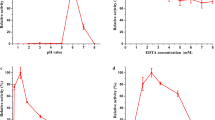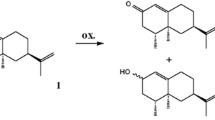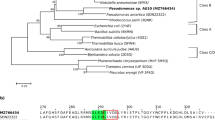Abstract
It is useful to identify and examine organisms that may prove useful for the treatment of dye-contaminated wastewater. Here, we report the purification and characterization of a new versatile peroxidase (VP) from the decolorizing microbe, Thanatephorus cucumeris Dec 1 (TcVP1). The purified TcVP1 after Mono P column chromatography showed a single band at 43 kDa on sodium dodecyl sulfate–polyacrylamide gel electrophoresis. Amino acid sequencing revealed that the N terminus of TcVP1 had the highest homology to Trametes versicolor MPG1, lignin peroxidase G (LiPG) IV, Bjerkandera adusta manganese peroxidase 1 (MnP1), and Bjerkandera sp. RBP (12 out of 14 amino acid residues, 86% identity). Mn2+ oxidizing assay revealed that TcVP1 acted like a classical MnP at pH ∼5, while dye-decolorizing and oxidation assays of aromatic compounds revealed that the enzyme acted like a LiP at pH ∼3. TcVP1 showed particularly high decolorizing activity toward azo dyes. Furthermore, coapplication of TcVP1 and the dye-decolorizing peroxidase (DyP) from T. cucumeris Dec 1 was able to completely decolorize a representative anthraquinone dye, Reactive blue 5, in vitro. This decolorization proceeded sequentially; DyP decolorized Reactive blue 5 to light red-brown compounds, and then TcVP1 decolorized these colored intermediates to colorless. Following extended reactions, the absorbance corresponding to the conjugated double bond from phenyl (250–300 nm) decreased, indicating that aromatic rings were also degraded. These findings provide important new insights into microbial decolorizing mechanisms and may facilitate the future development of treatment strategies for dye wastewater.





Similar content being viewed by others
References
Altschul SF, Madden TF, Schäffer AA, Zhang J, Zhang Z, Miller W, Lipman DJ (1997) Gapped BLAST and PSI-BLAST: a new generation of protein database search programs. Nucleic Acid Res 25:3389–3402
Alva KS, Kumar J, Marx KA, Tripathy SK (1997) Enzymatic synthesis and characterization of a novel water-soluble polyaniline: poly(2,5-diaminobenzenesulfonate). Macromolecules 30:4024–4029
Amaral PF, Fernandes DL, Travares AP, Xavier AB, Cammarota MC, Coutinho JA, Coelho MA (2004) Decolorization of dyes from textile wastewater by Trametes versicolor. Environ Technol 25:1313–1320
Baldrian P (2004) Purification and characterization of laccase from the white-rot fungus Daedala quercina and decolorization of synthetic dyes by the enzyme. Appl Microbiol Biotechnol 63:560–563
Banat IM, Nigam P, Singh D, Marchant R (1996) Microbial decolorization of textile-dye-containing effluents: a review. Bioresour Technol 58:217–227
Bradford MM (1976) A rapid and sensitive method for the quantification of microgram quantities of protein utilizing the principle of protein-dye binding. Anal Biochem 72:248–254
Camarero S, Böckle B, Martínez MJ, Martínez AT (1996) Manganese-mediated lignin degradation by Pleurotus pulmonarius. Appl Environ Microbiol 62:1070–1072
Camarero S, Sarkar S, Ruiz-Dueñas FJ, Martínez MJ, Martínez AT (1999) Description of a versatile peroxidase in the natural degradation of lignin that has both manganese peroxidase and lignin peroxidase substrate interaction sites. J Biol Chem 274:10324–10330
Champagne PP, Ramsay JA (2005) Contribution of manganese peroxidase and laccase to dye decoloration by Trametes versicolor. Appl Microbiol Biotechnol 69:276–285
Claus H, Faber G, Koning H (2002) Redox-mediated decolorization of synthetic dyes by fungal laccases. Appl Microbiol Biotechnol 59:672–678
Cohen R, Persky L, Hazan-Eitan Z, Yarden O, Hadar Y (2002) Mn2+ alters peroxidase profiles and lignin degradation by the white-rot fungus Pleurotus ostreatus under different nutritional and growth conditions. Appl Biochem Biotechnol 102–103:415–429
Cripps C, Bumpus JS, Aust SD (1990) Biodegradation of azo and heterocyclic dyes by Phanerochaete chrysosporium. Appl Environ Microbiol 56:1114–1118
de Boer HA, Zhang YZ, Collins C, Reddy CA (1987) Analysis of nucleotide sequences of two ligninase cDNA from a white-rot fungus, Phanerochaete chrysosporium. Gene 60:93–102
Edman P (1949) A method for the determination of the amino acid sequence in peptides. Arch Biochem Biophys 22:475–476
Forrester IT, Grabski AC, Mishra C, Kelley BL, Atrickland WN, Leatham GF, Burgess RR (1990) Characteristics and N-terminal amino acid sequence of manganese peroxidase purified from Lentinus edodes cultures grown on commercial wood substrate. Appl Microbiol Biotechnol 33:359–365
Glenn JK, Gold MH (1983) Decolorization of several polymeric dyes by the lignin-degrading basidiomycete Phanerochaetechrysosporium. Appl Environ Microbiol 45:1741–1747
Glenn JK, Gold MH (1985) Purification and characterization of an extracellular Mn(II)-dependent peroxidase from the lignin-degrading basidiomycete, Phanerochaete chrysosporium. Arch Biochem Biophys 242:329–341
Gold MH, Kuwahara M, Chiu AA, Glenn JK (1984) Purification and characterization of an extracellular H2O2-requiring diarylpropane oxdygenase from the white rot basidiomycete, Phanerochaete chrysosporium. Arch Biochem Biophys 234:353–362
Gómez-Toribio V, Martínez AT, Martínez MJ (2001) Oxidation of hydroquinones by the versatile ligninolytic peroxidase from Pleurotus eryngii. Eur J Biochem 268:4787–4793
Heinfling A, Bergbauer M, Szewzyk U (1997) Biodegradation of azo and phthalocynanide dyes by Trametes versicolor and Bjerkandera adusta. Appl Microbiol Biotechnol 48:261–266
Heinfling A, Martínez MJ, Martínez AT, Bergbauer M, Szewzyk U (1998a) Purification and characterization of peroxidases from the dye-decolorizing fungus Bjerkandera adusta. FEMS Microbiol Lett 165:43–50
Heinfling A, Martínez MJ, Martínez AT, Bergbauer M, Szewzyk U (1998b) Transformation of industrial dyes by manganese peroxidase from Bjerkandera adusta and Pleurotus eryngii in a manganese-independent reaction. Appl Environ Microbiol 64:2788–2793
Heinfling A, Ruiz-Dueñas FJ, Martínez MJ, Bergbauer M, Szewzyk U, Martínez AT (1998c) A study on reducing substrates of manganese-oxidizing peroxidases from Pleurotus eryngii and Bjerkandera adusta. FEBS Lett 428:141–146
Ichinohe D, Muranaka T, Sasaki T, Kobayashi M, Kise H (1998) Oxidative polymerization of phenylensiamines catalyzed by horseradish peroxidase. J Polym Sci A Polym Chem 36:2593–2600
Itoh K, Kitade Y, Yatone C (1996) A pathway for biodegradation of anthraquinone dye, C. I. Disperse red 15, by a yeast strain Pichia anomala. Bull Environ Contam Toxicol 56:413–418
Itoh K, Kitade Y, Yatone C (1998) Oxidative biodegradation of an anthraquinone dye, pigment violet 12, by Coriolus versicolor. Bull Environ Contam Toxicol 60:786–790
Johansson T, Nyman PO (1996) A cluster of genes encoding major isoenzymes of lignin peroxidase and manganese peroxidase from the white-rot fungus Trametes versicolor. Gene 170:31–38
Kamitsuji H, Watanabe T, Honda Y, Kuwahara M (2005) Direct oxidation of polymeric substrates by multifunctional manganese peroxidase isoenzyme from Pleurotus ostreatus without redox mediators. Biochem J 386:387–393
Kim SJ, Shoda M (1999) Purification and characterization of a novel peroxidase from Geotricum candidum Dec 1 involved in decolorization of dyes. Appl Environ Microbiol 65:1029–1035
Kim SJ, Ishikawa K, Hirai M, Shoda M (1995) Characteristics of a newly isolated fungus, Geotrichum candidum Dec1, which decolorizes various dyes. J Ferment Bioeng 9:601–607
Kim SJ, Suzuki N, Uematsu Y, Shoda M (2001) Characterization of aryl alcohol oxidase produced by decolorizing fungus, Geotrichum candidum Dec 1. J Biosci Bioeng 91:166–172
Laemmli UK (1970) Cleavage of structural proteins during the assembly of the head of bacteriophage T4. Nature (Lond) 277:680–685
Lee TH, Aoki H, Sugano Y, Shoda M (2000) Effect of molasses on the production and activity of dye-decolorizing peroxidase from Geotrichum candidum Dec 1. J Biosci Bioeng 89:545–549
Liu W, Chao Y, Yang X, Bao H, Qian S (2004) Biodecolorization of azo, anthraquinonic and triphenylmethane dyes by white-rot fungi and a laccase-secreting engineered strain. J Ind Microbiol Biotech 31:127–132
Lobos S, Larrain J, Lorero S, Cullen D, Vicuna R (1994) Isoenzymes of manganese-dependent peroxidase and laccase produced by the lignin-degrading basidiomycete Ceriporiopsis subvermispora. Microbiology 140:2691–2698
Martínez MJ, Ruiz-Dueñas FJ, Guillen F, Martínez AT (1996) Purification and catalytic properties of two manganese peroxidase isoenzymes from Pleurotus eryngii. Eur J Biochem 237:424–432
McMullan G, Meehan C, Conneely A, Kirby N, Robinson T, Nigam P, Banat IM, Marchant R, Smyth WF (2001) Microbial decolourisation and degradation of textile dyes. Appl Microbiol Biotechnol 56:81–87
Mester T, Field JA (1998) Characterization of a novel manganese peroxidase-lignin peroxidase hybrid isozyme produced by Bjerkandera species strain BOS55 in the absence of manganese. J Biol Chem 273:15412–15417
Moreira PR, Duez C, Dehareng D, Antunes A, Almeida-Vala E, Frère JM, Malcata FX, Duarte JC (2005) Molecular characterization of a versatile peroxidase from a Bjerkandera strain. J Biotechnol 118:339–352
Pasczynski A, Crawford RL (1991a) Degradation of azo compounds by ligninase from Phanerochaetechyrsosporium: involvement of veratryl alcohol. Biochem Biophys Res Commun 178:1056–1063
Paszczynski A, Pasti MB, Goszczynski S, Crawford DL, Crawford RL (1991b) New approach to improve degradation of recalcitrant azo dyes by Streptomyces spp. and Phanerochaetechrysosporium. Enzyme Microb Technol 13:378–384
Paszczynski A, Pasti MB, Goszczynski S, Crawford RL, Crawford DL (1992) Mineralization of sulfonated azo dyes and sulfanilic acid by Phanerochaete chrysosporium and Streptmyceschromfuscus. Appl Environ Microbiol 58:3598–3604
Platt MW, Hadar Y, Chet I (1985) The decolorization of the polymeric dye poly-blue (polyvinylaminesulfonate-anthraquinone) by lignin degrading fungi. Appl Microbiol Biotechnol 21:394–396
Pogni R, Baratto MC, Giansanti S, Teutloff C, Verdin J, Valderrama B, Lendzian F, Lubitz W, Vazquez-Duhalt R, Basosi R (2005) Tryptophan-based radical in the catalytic mechanism of versatile peroxidase from Bjerkandera adusta. Biochemistry 44:4267–4274
Pribnow D, Mayfield MB, Nipper VJ, Brown JA, Gold MH (1989) Characterization of a cDNA encoding a manganese peroxidase, from the lignin-degrading basidiomycete Phanerochaete chrysosporium. J Biol Chem 264:5036–5040
Richardson ML (1983) Dyes—the aquatic environment and the mess made by metabolites. J Soc Dyers Colour 99:198–200
Ruiz-Dueñas FJ, Martínez MJ, Martínez AT (1999a) Heterologous expression of Pleurotus eryngii peroxidase confirms its ability to oxidize Mn2+ and different aromatic substrates. Appl Environ Microbiol 65:4705–4707
Ruiz-Dueñas FJ, Martínez MJ, Martínez AT (1999b) Molecular characterization of a novel peroxidase isolated from the ligninolytic fungus Pleurotus eryngii. Mol Microbiol 31:223–235
Ruiz-Dueñas FJ, Camarero S, Perez-Boada M, Martínez MJ, Martínez AT (2001) A new versatile peroxidase from Pleurotus. Biochem Soc Trans 29:116–122
Saitou N, Nei M (1987) The neighbor-joining method: a new method for reconstructing phylogenetic trees. Mol Biol Evol 4:406–425
Sarkar S, Martínez AT, Martínez MJ (1997) Biochemical and molecular characterization of manganese peroxidase isoenzyme from Pleurotus ostreatus. Biochim Biophys Acta 1339:23–30
Sato T, Hara S, Matsui T, Sazaki G, Saijo S, Ganbe T, Tanaka N, Sugano Y, Shoda M (2004) A unique dye-decolorizing peroxidase, DyP, from Thanatephorus cucumeris Dec 1: heterologous expression, crystallization and preliminary X-ray analysis. Acta Crystallogr D 60:149–152
Schneegaß I, Hofrichter M, Scheibner K, Fritsche W (1997) Purification of the main manganese peroxidase from the white-rot fungus Nematoloma frowardii b19. Appl Microbiol Biotechnol 48:602–605
Shah V, Nerud F (2002) Lignin degrading system of white-rot fungi and its exploitation for dye decolorization. Can J Microbiol 48:857–870
Shintani N, Sugano Y, Shoda M (2002) Decolorization of kraft pulp bleaching effluent by a newly isolated fungus, Geotrichum candidum Dec 1. J Wood Sci 48:402–408
Sokal RR, Michener CD (1958) A statistical method for evaluating systematic relationships. Univ Kansas Sci Bull 28:1409–1438
Spadaro JT, Gold MH, Reganathan V (1992) Degradation of azo dyes by the lignin-degrading fungus Phanerochaete chrysosporium. Appl Environ Microbiol 58:2397–2401
Stolz A (2001) Basic and applied aspects in the microbial degradation of azo dyes. Appl Microbiol Biotechnol 56:69–80
Sugano Y, Sasaki K, Shoda M (1999) cDNA cloning and genetic analysis of a novel decolorizing enzyme, peroxidase gene dyp from Geotrichum candidum Dec 1. J Biosci Bioeng 87:411–417
Sugano Y, Nakano R, Sasaki K, Shoda M (2000) Efficient heterologous expression in Aspergillus oryzae of a unique dye-decolorizing peroxidase, DyP, of Geotrichum candidum Dec 1. Appl Environ Microbiol 66:1754–1758
Sugano Y, Matsuo C, Shoda M (2001) Efficient production of a heterologous peroxidase, DyP from Geotrichum candidum Dec 1, on solid-state culture of Aspergillus oryzae RD005. J Biosci Bioeng 92:594–597
Tien M, Kirk TK (1984) Lignin-degrading enzyme from Phanerochaete chrysosporium: purification, characterization, and catalytic properties of a unique H2O2-requiring oxygenase. Proc Natl Acad Sci U S A 81:2280–2284
Vaidya AA, Datye KV (1982) Environmental pollution during chemical processing of synthetic fibers. Colourage 14:3–10
Wesenberg D, Kyriakides I, Agathos SN (2003) White-rot fungi and their enzymes for the treatment of industrial dye effluents. Biotechnol Adv 22:161–187
Young L, Yu J (1997) Ligninase-catalysed decolorization of synthetic dyes. Water Res 31:1187–1193
Yuzhu F, Viraraghavan T (2001) Fungal decolorization of dye waste waters: a review. Bioresour Technol 79:251–262
Zollinger H (1987) Color chemistry-synthesis, properties and applications of organic dyes and pigments. VCH, New York, pp 92–100
Author information
Authors and Affiliations
Corresponding author
Rights and permissions
About this article
Cite this article
Sugano, Y., Matsushima, Y. & Shoda, M. Complete decolorization of the anthraquinone dye Reactive blue 5 by the concerted action of two peroxidases from Thanatephorus cucumeris Dec 1. Appl Microbiol Biotechnol 73, 862–871 (2006). https://doi.org/10.1007/s00253-006-0545-9
Received:
Revised:
Accepted:
Published:
Issue Date:
DOI: https://doi.org/10.1007/s00253-006-0545-9




